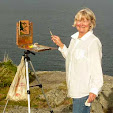Ocean Hues
18"x18" acrylic on canvas
Sold
I'm showing a painting today that I did a couple of months ago but never posted. It's part of an exploration of abstraction using acrylics, rags, and a knife. The idea of using these tools for acrylic abstracts came from Leslie Saeta, when I took her palette knife painting workshop in March. See Leslie's beautiful abstracts here.
In preparing "Ocean Hues" for the buyer, I learned a bit about varnishing acrylics, which I'd like to share. I generally varnish my oil paintings, either using an archival varinish applied with a brush (Winsor Newton Conserv-Art Gloss Varnish), if the painting has been dry for months, or a spray retouch varnish (Blair Retouch Spray Varnish), if the painting is just dry to the touch. The reason for this is as much to even out the gloss as it is to protect the painting. I plan to also try Gamvar (Gamblin) for both of these uses.
It turns out that varnishing acrylics is even more important than varnishing an oil painting. In addition to the need to even out the gloss and protect the painting, acrylic paint attracts dirt, and varnish can protect from this. I took a look at several websites (references below) and realized it could be a pretty complicated process. I read about isolation layers, and the need to practice varnishing techniques before using them on a painting. I tried an isolation layer of Golden Regular Gloss Medium (2 coats), brushed on. Once dry, I applied Golden MSA spray, because I thought the UV protection would be useful in the environment where the painting would be going. My mistake was in buying gloss MSA spray. The result was a painting that was so shiny it looked like there was a piece of glass in front of it! Fortunately I wasn't practicing on the already sold painting.
At this point Leslie recommended Bob Burridge's approach (see last reference below), which is to brush on Minwax Polycrylic Protective Finish (satin). It's very easy to use, since it's water based. The only tricky bit, is to not over brush. Meaning, don't go back over what you've already brushed on, even a few minutes later. I learned this the hard way. The good news is that the final coat is what matters, in terms of sheen, so if you mess it up, just put on another coat. I was also able to fix the test painting that was too shiny, by adding a few coats of the Minwax. Thank you, Leslie!
At this point Leslie recommended Bob Burridge's approach (see last reference below), which is to brush on Minwax Polycrylic Protective Finish (satin). It's very easy to use, since it's water based. The only tricky bit, is to not over brush. Meaning, don't go back over what you've already brushed on, even a few minutes later. I learned this the hard way. The good news is that the final coat is what matters, in terms of sheen, so if you mess it up, just put on another coat. I was also able to fix the test painting that was too shiny, by adding a few coats of the Minwax. Thank you, Leslie!
References:
http://willkempartschool.com/how-you-can-charge-more-for-a-varnished-painting/
Referenced in the above:
http://www.goldenpaints.com/technicalinfo_varnapp
http://willkempartschool.com/adding-an-isolation-coat-to-an-acrylic-painting/
http://www.robertburridge.com/Weekly_BobBlast/Issue_46/VarnishHandout2013.pdf



Love the colors. Your color palette and mine are very similar today. Check it out... http://cagleyart.blogspot.com/
ReplyDeleteConnie